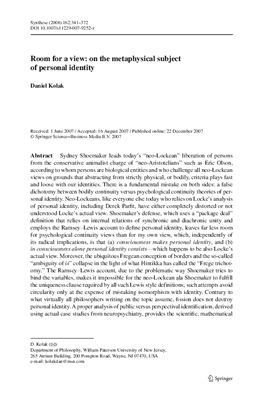Колак Даниель. Место для одного взгляда: о метафизическом
субъекте.
Год: 2007
Sydney Shoemaker leads today’s neo-Lockean liberation of persons from the conservative animalist charge of neo-Aristotelians such as Eric Olson, according to whom persons are biological entities and who challenge all neo-Lockean views on grounds that abstracting from strictly physical, or bodily, criteria plays fast and loose with our identities. There is a fundamental mistake on both sides: a false dichotomy between bodily continuity versus psychological continuity theories of personal identity. Neo-Lockeans, like everyone else today who relies on Locke’s analysis of personal identity, including Derek Parfit, have either completely distorted or not understood Locke’s actual view. Shoemaker’s defense, which uses a package deal definition that relies on inteal relations of synchronic and diachronic unity and employs the Ramsey–Lewis account to define personal identity, leaves far less room for psychological continuity views than for my own view, which, independently of its radical implications, is that (a) consciousness makes personal identity, and (b) in consciousness alone personal identity consists—which happens to be also Locke’s actual view.Moreover, the ubiquitous Fregean conception of borders and the so-called ambiguity of is collapse in the light of what Hintikka has called the Frege trichotomy. The Ramsey–Lewis account, due to the problematic way Shoemaker tries to bind the variables, makes it impossible for the neo-Lockean ala Shoemaker to fulfill the uniqueness clause required by all such Lewis style definitions; such attempts avoid circularity only at the expense of mistaking isomorphism with identity. Contrary to what virtually all philosophers writing on the topic assume, fission does not destroy personal identity.Aproper analysis of public versus perspectival identification, derived using actual case studies from neuropsychiatry, provides the scientific, mathematical and logical frameworks for a new theory of self-reference, wherein consciousness, self-consciousness, and the I, can be precisely defined in terms of the subject and the subject-in-itself.
Год: 2007
Sydney Shoemaker leads today’s neo-Lockean liberation of persons from the conservative animalist charge of neo-Aristotelians such as Eric Olson, according to whom persons are biological entities and who challenge all neo-Lockean views on grounds that abstracting from strictly physical, or bodily, criteria plays fast and loose with our identities. There is a fundamental mistake on both sides: a false dichotomy between bodily continuity versus psychological continuity theories of personal identity. Neo-Lockeans, like everyone else today who relies on Locke’s analysis of personal identity, including Derek Parfit, have either completely distorted or not understood Locke’s actual view. Shoemaker’s defense, which uses a package deal definition that relies on inteal relations of synchronic and diachronic unity and employs the Ramsey–Lewis account to define personal identity, leaves far less room for psychological continuity views than for my own view, which, independently of its radical implications, is that (a) consciousness makes personal identity, and (b) in consciousness alone personal identity consists—which happens to be also Locke’s actual view.Moreover, the ubiquitous Fregean conception of borders and the so-called ambiguity of is collapse in the light of what Hintikka has called the Frege trichotomy. The Ramsey–Lewis account, due to the problematic way Shoemaker tries to bind the variables, makes it impossible for the neo-Lockean ala Shoemaker to fulfill the uniqueness clause required by all such Lewis style definitions; such attempts avoid circularity only at the expense of mistaking isomorphism with identity. Contrary to what virtually all philosophers writing on the topic assume, fission does not destroy personal identity.Aproper analysis of public versus perspectival identification, derived using actual case studies from neuropsychiatry, provides the scientific, mathematical and logical frameworks for a new theory of self-reference, wherein consciousness, self-consciousness, and the I, can be precisely defined in terms of the subject and the subject-in-itself.

